 Like Ruta 40 in Argentina, Chile also has a legendary road: the “Carretera Austral”, a 1,240-kilometer-long gravel road through Chilean Patagonia. The road was built in 1976 on the request of Chilean dictator Pinochet, then as the “Carretera General Augusto Pinochet”. Previous attempts to build a road through the inhospitable south of Chile had failed. Because of the harsh weather, access via the sea or the air also was difficult, due to which the south of Chile was only accessible from Argentina for a long time. When both countries became embroiled in a conflict, the Chilean army was deployed to build a road. An ambitious project involving a large number of casualties.
Like Ruta 40 in Argentina, Chile also has a legendary road: the “Carretera Austral”, a 1,240-kilometer-long gravel road through Chilean Patagonia. The road was built in 1976 on the request of Chilean dictator Pinochet, then as the “Carretera General Augusto Pinochet”. Previous attempts to build a road through the inhospitable south of Chile had failed. Because of the harsh weather, access via the sea or the air also was difficult, due to which the south of Chile was only accessible from Argentina for a long time. When both countries became embroiled in a conflict, the Chilean army was deployed to build a road. An ambitious project involving a large number of casualties.
The road was opened to the public in 1988 and has since drawn many travellers. Not because of the remarkable history of the road, but mainly because of the extraordinarily beautiful landscape. From Puerto Montt, the road goes through a dense Valerian rainforest, along fjords, glaciers, deep blue lakes and villages where time has stood still. A route that was voted “the most beautiful road ever ridden” by several of our motorcycling friends. No wonder that we also wanted to have a look.
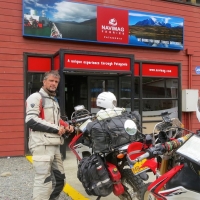 After a few nice days in Puerto Varas with Megan and Matthew we ride to Puerto Montt, the starting point of the Carretera Austral. Before we begin our journey south, we first buy tickets for the ferry in the center of town. On our way to the end of the Carretera Austal in Villa O’Higgins, we need to take a ferry a few times and for two of those we have to buy our tickets here. Luckily we find the office of Navimag very quickly and are able to leave the busy city and get on our way.
After a few nice days in Puerto Varas with Megan and Matthew we ride to Puerto Montt, the starting point of the Carretera Austral. Before we begin our journey south, we first buy tickets for the ferry in the center of town. On our way to the end of the Carretera Austal in Villa O’Higgins, we need to take a ferry a few times and for two of those we have to buy our tickets here. Luckily we find the office of Navimag very quickly and are able to leave the busy city and get on our way.
The road runs right along the water and although we are very far inland we are right next to the ocean. In some places, the sea flows over 100km inland. The salty air smells great and the climate seems to be milder here as well. At the beginning of the afternoon we arrive in the village of La Arena where we take the first ferry. It is only a short distance to the other side of the fjord, so we stay with the bikes during the crossing. And that is a good thing, because the sea in rough and the ferry rocks so much that the bikes almost fall over. Due to the rocking I am green within a few seconds and have to stare at the horizon continuously to avoid hanging over the railing. It is a big relief when we reach the other side.
 Until La Arena we drove on a smooth, new asphalt road, but once we get off the ferry in Caleta Puelche the gravel road starts. And at the same time the dust. The cars that were on the ferry with leave the boat first and as soon as they hit the gravel road a huge cloud of dust is in the sky. We wait a while until the cars are out of sight and the dust is gone, and then continue. The gravel road is in good condition. There are some potholes in the road, but those cause little trouble to us on the bikes. On the side of the road are some slightly higher piles with gravel that can be annoying, but as long as we keep going straight and don’t hit those piles, it is fine.
Until La Arena we drove on a smooth, new asphalt road, but once we get off the ferry in Caleta Puelche the gravel road starts. And at the same time the dust. The cars that were on the ferry with leave the boat first and as soon as they hit the gravel road a huge cloud of dust is in the sky. We wait a while until the cars are out of sight and the dust is gone, and then continue. The gravel road is in good condition. There are some potholes in the road, but those cause little trouble to us on the bikes. On the side of the road are some slightly higher piles with gravel that can be annoying, but as long as we keep going straight and don’t hit those piles, it is fine.
At the end of the day we arrive in Hornopiren, a seaside village from where the second ferry will leave. We had heard that it is a nice place to stay a bit longer and therefore bought tickets for the ferry of the day after tomorrow to be able to stay here two nights. At the local tourist office we inquire about a place to sleep and to our surprise the lady refers us to a campsite in a botanical garden. We follow her instructions and ride right along the coast until we reach Camping Patagonia El Cobre.
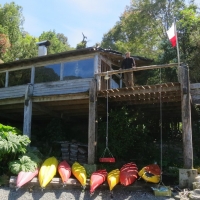 Peter walks up to check the campings spots and comes back after ten minutes with a friendly boy, who has just showed him the campsite. The botanical garden is made by his father in their ’backyard’, a large piece of land abutting against a steep mountainside. The boy takes us to a beautiful wooden house on poles where the reception of the campsite is. In the ‘cafe’, as he calls it, is a small kitchenette, are some tables and chairs and also a cozy sitting area around a fireplace. The area is full of beautiful books, musical instruments, old typewriters, wooden furniture and bottles that were found on the beach. From the ’cafe’ we have an amazing view over the ocean. A great place and I would love to trade our apartment in the city for this wooden house!
Peter walks up to check the campings spots and comes back after ten minutes with a friendly boy, who has just showed him the campsite. The botanical garden is made by his father in their ’backyard’, a large piece of land abutting against a steep mountainside. The boy takes us to a beautiful wooden house on poles where the reception of the campsite is. In the ‘cafe’, as he calls it, is a small kitchenette, are some tables and chairs and also a cozy sitting area around a fireplace. The area is full of beautiful books, musical instruments, old typewriters, wooden furniture and bottles that were found on the beach. From the ’cafe’ we have an amazing view over the ocean. A great place and I would love to trade our apartment in the city for this wooden house!
The botanical garden is actually a dense forest with tall trees, orchids, vines, moss and many ferns. In the forest are four camping spots. We are the only guests and pitch our tent on a spot under a wooden roof. It is like sleeping in a forest hut. The friendly boy had told us that the evenings can be quite chilly and had advised us to start a campfire. You only have to say that once to Peter, because he goes into the woods and comes back a little later with a pile of branches and some big logs. Not long after, we sit with our plate of pasta around a roaring campfire. It is chilly, so we sit closer and closer by the fire until all the wood in gone and we crawl into our sleeping bags. Although our tent is in the forest, far away from the village and the civilized world, it is not quiet at all that night. 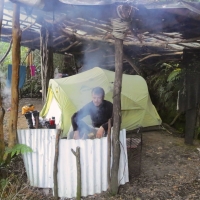 From the puddles in the forest sounds a loud croaking of the frogs and in the trees above us are birds that make strange sounds. We are tired from the long day on the bikes and fall asleep despite the ’noise’.
From the puddles in the forest sounds a loud croaking of the frogs and in the trees above us are birds that make strange sounds. We are tired from the long day on the bikes and fall asleep despite the ’noise’.
The next morning it is again an animal sound that wakes us up. We do not know the sound and are so curious we cannot stay in ours beds. We crawl from our sleeping bags and walk -still in our pyjama’s- with the binoculars to the terrace of the ‘café’ to where the sound is coming from. We scour off the bay and see: sea lions! In the bay are several buoys and on each buoy is a sea lion. One by one they throw back their head to then let out a loud cry, it sounds a bit like a horn of a car. They are quite far away, but their call sounds so hard that it is like they are just a few meters away. And those are not the only animals we see. While we search the water with the binoculars, we see a group of dolphins! They swim in the bay and are clearly hunting. What an awesome sight! We take a seat on the terrace in the morning sun and watch them as long as possible, until it really is time to get dressed and eat breakfast.
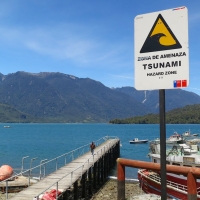 After breakfast we walk to the center to do some shopping. It is low tide and the water has drawn back a few meters. On the dry pebble beach are some beautiful wooden fishing boats waiting for high tide. All along the coast are signs that warn for ‘Tsunami danger’ and in the village itself are signs on which the evacuation route is indicated. In Chile earthquakes happen quite often, sometimes followed by a tsunami. Until now, we did not experience any earthquakes on our trip, but nevertheless we take a good look at the signs to know where to go in case of emergency.
After breakfast we walk to the center to do some shopping. It is low tide and the water has drawn back a few meters. On the dry pebble beach are some beautiful wooden fishing boats waiting for high tide. All along the coast are signs that warn for ‘Tsunami danger’ and in the village itself are signs on which the evacuation route is indicated. In Chile earthquakes happen quite often, sometimes followed by a tsunami. Until now, we did not experience any earthquakes on our trip, but nevertheless we take a good look at the signs to know where to go in case of emergency.
Back at the campsite Peter keeps searching in his bag until he finds what he was looking for: his fishing equipment. “I’m going fishing!!” he shouts while he already start running down the stairs toward the waterfront. Motorcycling might now be one of his passions, Peter once spent a lot of time with a fishing rod on the waterfront. The travel fishing rod that we previously took to trips in Europe did not make it to our packing list for this trip: the rod was too big. Instead, Peter made his own ’fishing-cane’ with a long line wrapped around a piece of pipe. When I join him a little while later, he has already caught seven fish! It is going well! Peter swings the line around, throws it into the water and then pulls the line again with short, fast pulls. 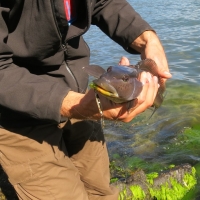 The fish keep biting, because half an hour later the counter is already on 12, one fish even bigger than the other. Fun to do, especially in the sun on such a beautiful fjord!
The fish keep biting, because half an hour later the counter is already on 12, one fish even bigger than the other. Fun to do, especially in the sun on such a beautiful fjord!
The next morning the sea lions wake us up again. We have our breakfast in the café and can take our time because the ferry only leaves at the end of this morning. The sea lions give a wonderful concert and even the dolphins are back in the bay to hunt for their breakfast. What a great place!
After breakfast we pack our bags and head for the ferry. The boat is already lying in the bay. We report to one of the stewards and are allowed to drive onto the boat. We park the bikes next to a row of motorcycles and then look for a seat on the upper deck. The water is calm and the boat is pretty big, so we do not need to worry that the boat will be rocking so much that the bikes will fall. Moreover, it is a boat trip of five hours, so it will be quit nice to sit down. If the cars and the local bus have also found a place on the boat, the horn sounds and the ferry starts moving. We see Hornopiren and the adjacent volcano getting smaller as we go further into the fjord. It is a beautiful trip, with steep green mountains on both sides and a thin layer of snow on the top.
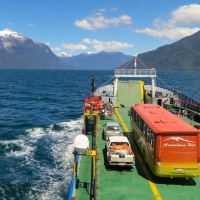 In the first kilometer after Hornopiren we see some houses, but now we only see nature. There are no houses, no roads and not even electricity poles. This is because we are sailing along Pumalin National Park, a huge nature reserve that was the property of Douglas Thompkins until recently. The American businessman who founded Esprit and The North Face, bought a number of adjacent farms south of Hornopiren as of 1991 with the aim to give the land back to nature. In the ten years that followed he bought more and more land until he had created a huge nature reserve or over 3,200 km2. In 2005 the area was given back to the Chilean government on the condition that it would be declared a National Park, with which the protection of this unique part of nature was preserved. Thompkins had wanted to promote the ‘wilderness experience’ of visitors and for that reason the park offers lots of opportunities for hiking and camping. What is missing is a main road in the northern part of the park, which is also why we are now on a ferry instead of our bikes. Although there is a lot of speculation about the extension of the Carretera Austral through this part of the National Park, it is still uncertain whether there will ever be a road.
In the first kilometer after Hornopiren we see some houses, but now we only see nature. There are no houses, no roads and not even electricity poles. This is because we are sailing along Pumalin National Park, a huge nature reserve that was the property of Douglas Thompkins until recently. The American businessman who founded Esprit and The North Face, bought a number of adjacent farms south of Hornopiren as of 1991 with the aim to give the land back to nature. In the ten years that followed he bought more and more land until he had created a huge nature reserve or over 3,200 km2. In 2005 the area was given back to the Chilean government on the condition that it would be declared a National Park, with which the protection of this unique part of nature was preserved. Thompkins had wanted to promote the ‘wilderness experience’ of visitors and for that reason the park offers lots of opportunities for hiking and camping. What is missing is a main road in the northern part of the park, which is also why we are now on a ferry instead of our bikes. Although there is a lot of speculation about the extension of the Carretera Austral through this part of the National Park, it is still uncertain whether there will ever be a road.
After five hours the ferry stops at the end of the long fjord in Leptepu. This is not our final destination for today, because we have to cross one more fjord today. And the ferry leaves about 15 minutes later on the other side of the peninsula where we have just moored.  We start riding to the second ferry of today, and set of first to stay in front of the cars and their dust. Once all the cars and the bus have also reached the ferry the horn sounds for the second time that day and the ferry takes off. Half an hour later we reach Caleta Gonzalo. We leave the ferry before all the cars, but park at the top of the slope to let them pass. They all seem to be in a hurry and rush away. When the dust has settled, we also start the bikes.
We start riding to the second ferry of today, and set of first to stay in front of the cars and their dust. Once all the cars and the bus have also reached the ferry the horn sounds for the second time that day and the ferry takes off. Half an hour later we reach Caleta Gonzalo. We leave the ferry before all the cars, but park at the top of the slope to let them pass. They all seem to be in a hurry and rush away. When the dust has settled, we also start the bikes.
From Caleta Gonzalo we drive into the southern part of Park Pumalin. We ride on a narrow road into the woods, along ferns as high as trees and streams that have carved a deep groove in the mountain. There is not a lot of water in the streams now, but in spring there has to be a lot of water here. We drive deeper into the jungle and feel like we are on the set of Jurassic Park. In the dense woods are thick, tall trees that are covered from top to bottom with moss, orchids and ’oldmans beard’. On the ground are ferns and all kinds of moss and from the branches hang thick vines. Really, a dinosaur would not stand out!
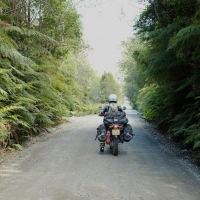 A little further we have a beautiful view over Lago Blanco, one of the lakes in the park. On the GPS we can see that there is a campsite next to the lake. We ride towards the waypoint and drive onto the camping ground. The campsite is part of the national park. There is no reception desk, but a sign clearly indicates that we can pitch our tent on one of the marked spots. We initially do not see any pitches, but if we look closer we see that some paths lead into the forest to the waterfront. We follow one of the paths and arrive at a truly amazing camping spot. Right in the dense forest, at the waterfront, overlooking the lake and the mountains beyond. Wow! We pitch the tent, open a bottle of wine and just sit there enjoying the view. Look where we are now!
A little further we have a beautiful view over Lago Blanco, one of the lakes in the park. On the GPS we can see that there is a campsite next to the lake. We ride towards the waypoint and drive onto the camping ground. The campsite is part of the national park. There is no reception desk, but a sign clearly indicates that we can pitch our tent on one of the marked spots. We initially do not see any pitches, but if we look closer we see that some paths lead into the forest to the waterfront. We follow one of the paths and arrive at a truly amazing camping spot. Right in the dense forest, at the waterfront, overlooking the lake and the mountains beyond. Wow! We pitch the tent, open a bottle of wine and just sit there enjoying the view. Look where we are now!
The next morning we stay in our warm beds a long time. The sun is up, but in the shade of the trees it is still pretty chilly. Only mid-morning I dare to go out of my sleeping bag to get water for the coffee. And while I am in the toilet block, I might as well take a shower. With a toe I feel the water of the shower and it is very, very cold. I do want to freshen up. Peter usually directly gets in the shower, even if the water is as cold as this one, but I am not brave enough for that. I first wet my legs, then my arms and then my head and face and only at the very end I get in the shower. Brrr!! I am clean, but this is without a doubt the coldest shower I have ever voluntarily taken!
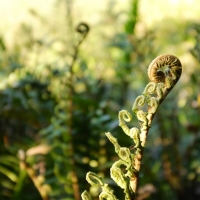 After a strong cup of coffee to warm, we continue our journey on the Carretera Austral. At the end of the morning we arrive in Chaiten where we refuel and do some shopping. The local supermarket has fresh bread, but that is the only thing that is fresh. The fruits and vegetables are old and almost crawl from the counter themselves from pure misery. We decide to eat bread tonight and to find a restaurant for lunch. We find a table at Café del Volcano where a friendly lady asks us what we want to eat. In our best Spanish we as for the menu, but she does not have one. She tells us what is on the menu, but she talks so fast that we do not understand a thing and end up pointing to the plate of our neighbor. Unfortunately, she does not have that good looking chicken anymore. We eventually choose ‘lomo’, which we had understand is “meat” (though we still not know from which animal). Moments later she comes out of the kitchen with two plates with two huge steaks and green salad. The meat is super tender and tastes great! This is a good way to learn Spanish, because “lomo” is a word we will not forget soon!
After a strong cup of coffee to warm, we continue our journey on the Carretera Austral. At the end of the morning we arrive in Chaiten where we refuel and do some shopping. The local supermarket has fresh bread, but that is the only thing that is fresh. The fruits and vegetables are old and almost crawl from the counter themselves from pure misery. We decide to eat bread tonight and to find a restaurant for lunch. We find a table at Café del Volcano where a friendly lady asks us what we want to eat. In our best Spanish we as for the menu, but she does not have one. She tells us what is on the menu, but she talks so fast that we do not understand a thing and end up pointing to the plate of our neighbor. Unfortunately, she does not have that good looking chicken anymore. We eventually choose ‘lomo’, which we had understand is “meat” (though we still not know from which animal). Moments later she comes out of the kitchen with two plates with two huge steaks and green salad. The meat is super tender and tastes great! This is a good way to learn Spanish, because “lomo” is a word we will not forget soon!
From Chaiten we ride on a asphalt road. It is quite nice to ride here for a while, especially since we do not have to look at the road constantly. Yet it still is not nearly as nice as on the gravel road. The new asphalt road is very wide, flanked by a broad road shoulder and a wide gutter. The forest only begins a few meters beyond that. It is like we are riding ’along’ the forest on the asphalt road, while we are riding ’in’ the forest on the gravel road. That is much nicer! And this time we are happy to see the asphalt stop and we continue on the gravel road.
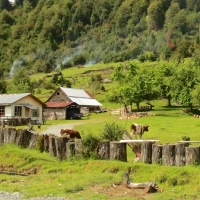 We have left the national park behind us and now see a bit more houses. These are mainly small farms where people seem to be fully self-sufficient. Next to the house is a vegetable garden, a greenhouse and are some fruit trees. In the pasture are a few cows, sheep and some chickens. And beside the house is enough firewood to heat the stove the next winters. They should also be able to take care of themselves, because the next house is miles away and it will certainly not be easy to reach it in winter. In many cases, it is questionable whether the house is connected to electricity, because even in the developed Chile that is not obvious. We drive through a few little villages with small farms like these, where it looks like time has stood still.
We have left the national park behind us and now see a bit more houses. These are mainly small farms where people seem to be fully self-sufficient. Next to the house is a vegetable garden, a greenhouse and are some fruit trees. In the pasture are a few cows, sheep and some chickens. And beside the house is enough firewood to heat the stove the next winters. They should also be able to take care of themselves, because the next house is miles away and it will certainly not be easy to reach it in winter. In many cases, it is questionable whether the house is connected to electricity, because even in the developed Chile that is not obvious. We drive through a few little villages with small farms like these, where it looks like time has stood still.
At the end of the day we arrive in La Junta, where we pitch our tent at a campsite in the center. We have only just tightened the canvas, when it starts to rain very hard. We eat in the tent and go to bed very early. The next morning we still hear drops falling on the tent. Once outside we feel that it is quite cold and see that the air still as dark as yesterday afternoon. The owner of the campsite predicts it will rain all day today. We put on warm clothes and put on our rain suits over our gear. We look like two “Michelin mans” and can barely move, but at least we are dry and warm.
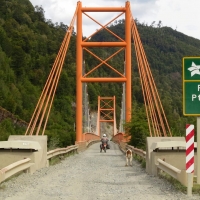 From La Junta, we are not only dealing with a lot of rain, but also with roadworks. Little by little the narrow gravel road is replaced by a wide asphalt road. The roadworks make driving quite challenging, not to say ‘difficult’. At one moment there is a lot of mud or deep sand, on another piece they have just added a new layer gravel in which our front wheel likes to play around and other parts we bounce over large loose boulders. And all of this in the pouring rain and on mountain roads with some deep descents just next to the road. Due to the road works often only one lane is open. We have to wait long before the road worker puts up his green flag to wave us through. Standing still in the pouring rain, with a visor that fogs up and no cars from the other side (which makes you sometimes wonder why we actually stop) is not our favorite activity.
From La Junta, we are not only dealing with a lot of rain, but also with roadworks. Little by little the narrow gravel road is replaced by a wide asphalt road. The roadworks make driving quite challenging, not to say ‘difficult’. At one moment there is a lot of mud or deep sand, on another piece they have just added a new layer gravel in which our front wheel likes to play around and other parts we bounce over large loose boulders. And all of this in the pouring rain and on mountain roads with some deep descents just next to the road. Due to the road works often only one lane is open. We have to wait long before the road worker puts up his green flag to wave us through. Standing still in the pouring rain, with a visor that fogs up and no cars from the other side (which makes you sometimes wonder why we actually stop) is not our favorite activity.
For a while, we ride right along the ocean and then we head for the mountains and ride up through the jungle. We pass a number of signs indicating that there is a ’mirador’: a viewpoint. It must be beautiful here, but unfortunately we do not see anything else than the fog in the valley and the drops that roll from our visors. These are no conditions to take out our cameras. Our rainwear is good, but after so much rain it now starts to leak at the seams. And somehow it always starts leaking at the crotch first! We are both cold and hungry and agree to stop at the next restaurant. The villages here are far apart and it takes a while before we find a restaurant. It looks closed, but there is smoke coming from the chimney, so they might still be open.
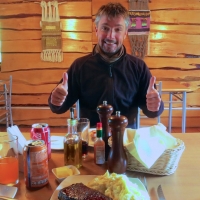 We park our bikes. The door opens and we see a little girl look around the corner. Then her father, the cook, comes to have a look. As soon as he sees our dripping suits, he opens the door, he welcomes us and throws new wood on the fire. While we peel ourselves slowly from our wet gear, he turns two seats toward the fire where we can sit. It is nice and warm! We look at his menu and see a word that we know: ‘lomo’! He apologizes that it may take a little while before the meat is ready, but he immediately sees that we do not mind. We almost sit in the fire and as we slowly thaw our cook, Victor, tells us about his village, the Carretera Austral, the harsh winters and the most beautiful places to visit. The meat tastes great! With a full stomach and -much importantly- dry clothes, we say goodbye and continue. When we step outside, the sun is trying to push away the clouds. That looks promising!
We park our bikes. The door opens and we see a little girl look around the corner. Then her father, the cook, comes to have a look. As soon as he sees our dripping suits, he opens the door, he welcomes us and throws new wood on the fire. While we peel ourselves slowly from our wet gear, he turns two seats toward the fire where we can sit. It is nice and warm! We look at his menu and see a word that we know: ‘lomo’! He apologizes that it may take a little while before the meat is ready, but he immediately sees that we do not mind. We almost sit in the fire and as we slowly thaw our cook, Victor, tells us about his village, the Carretera Austral, the harsh winters and the most beautiful places to visit. The meat tastes great! With a full stomach and -much importantly- dry clothes, we say goodbye and continue. When we step outside, the sun is trying to push away the clouds. That looks promising!
We have passed the roadworks and ride on the new asphalt road south. At the end of the day we turn off the main road to go to Camping Las Torres del Simpson. A place that was recommended to us by Megan and Matthew. It is a beautiful place in a green valley on the banks of the Rio Simpson. We are welcomed by the Spanish Nacho and his Chilean wife Sandra. We are the only guests and because the ground is so soggy from the rain, we can pitch our tent in the barn. 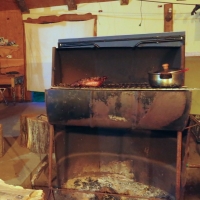 It is Friday and Nacho suggests that we join them for an ’asado’, a bbq. He will bring salad, wine, and the most important ingredient: a good piece of meat. That sounds great! That night Nacho, Sandra and their daughter come to the barn where our tent and their barbecue is. While the meat slowly cooks, Nacho takes his guitar to play some great songs with his daughter and his wife. They tell us about their life in the Chilean countryside, the long winters and their shared love of music. They play songs until everyone is sleepy from the wine and the good food and we decide it is time to go to bed.
It is Friday and Nacho suggests that we join them for an ’asado’, a bbq. He will bring salad, wine, and the most important ingredient: a good piece of meat. That sounds great! That night Nacho, Sandra and their daughter come to the barn where our tent and their barbecue is. While the meat slowly cooks, Nacho takes his guitar to play some great songs with his daughter and his wife. They tell us about their life in the Chilean countryside, the long winters and their shared love of music. They play songs until everyone is sleepy from the wine and the good food and we decide it is time to go to bed.
The next morning is again rains. We decide to stay on the camping until the weather is a bit better, so we do not need to ride in the rain and we can see a bit more from the area while riding. Moreover, this is a very nice place and we feel very welcome at Nacho and Sandra. But perhaps the most important reason to stay is the Rio Simpson which is full of trout! Peter can borrow a fishing rod from Nacho and catches one trout after another! Together we walk along the river to find the right fishing spot. After some instructions on how to throw and pull in the line, I even succeed to catch a trout! We throw all the fish back in the river and try to catch them again the next day.
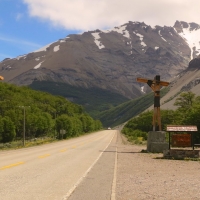 After three nights at the campsite the weather has improved and we wake up to a blue and cloudless sky. It is time to move on. We thank Nacho and Sandra and ride back to the main road. In the early morning we drive through one of the largest cities on the Carretera Austral: Coyhaique. Just before Coyhaique the beautiful forest stops and we see nothing but stumps in the country. Only after a couple of kilometers from Coyhaique we se tall, old trees again. Nacho told us that the wood is not only used for heating the house, but also for cooking, as a lot op people use wood burning stoves. To avoid that the beautiful old forests disappear the Chilean government stimulates people to cook on gas cylinders and has drawn up some rules about cutting trees. A good thing, because it is a sad to see all these barren plains.
After three nights at the campsite the weather has improved and we wake up to a blue and cloudless sky. It is time to move on. We thank Nacho and Sandra and ride back to the main road. In the early morning we drive through one of the largest cities on the Carretera Austral: Coyhaique. Just before Coyhaique the beautiful forest stops and we see nothing but stumps in the country. Only after a couple of kilometers from Coyhaique we se tall, old trees again. Nacho told us that the wood is not only used for heating the house, but also for cooking, as a lot op people use wood burning stoves. To avoid that the beautiful old forests disappear the Chilean government stimulates people to cook on gas cylinders and has drawn up some rules about cutting trees. A good thing, because it is a sad to see all these barren plains.
After Coyhaique we leave the ‘civilized world’ definitely behind and follow the gravel road into the wilderness. It is BEAUTIFUL! High ridges with jagged rocks, snow on the peaks and a river that meanders through the valley. After each turn we stop to take another picture of the view. It is clear that we are in a remote area of Chile, because the road is in poor condition and is clearly not as well maintained. There is hardly any traffic on the road, just some tourists. 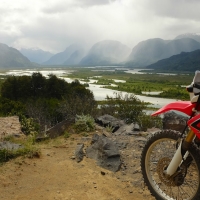 That night we sleep at a campsite in Puerto Tranquilo on a beautiful blue lake where we make plans to leave the Carretera Austral for a day and ride west. Nacho had shown us a road on the map which he called ‘the road of the glaciers.”
That night we sleep at a campsite in Puerto Tranquilo on a beautiful blue lake where we make plans to leave the Carretera Austral for a day and ride west. Nacho had shown us a road on the map which he called ‘the road of the glaciers.”
The next morning the sun is shining and it feels a few degrees warmer than the previous days. We do some shopping and make sure we have enough water if we want to bush camp that night. We drive through the small village of Puerto Tranquilo and get onto a narrow road that goes into the valley of the Rio Exploradores. It feels as if we leave the village through the back door. The road leads to several small farms and we meet several gauchos on the road, that are on their horse and with their cows on their way to their livestock. The valley becomes narrower and the road seems to be glued to the mountain. We often stop to take pictures, but also to see if the fish want to bite. Inspired by the record catch in the Rio Simpson Peter had bought some new gear in Coihayque and the fish seem to like it.
 From Puerto Tranquilo we drive all the way to the end of the road. It is 80km, a relatively small distance, but we are amazed about the variety of the area. We drive through a wide valley with green meadows, through a narrow gorge with waterfalls and rainforest, along hillsides full of big lava rocks and along a swamp. And just like Nacho said, we see large glaciers on top of the ridges. The meltwater comes down from the peaks with tremendous force and forms a light blue swirling river in the valley. It is breathtakingly beautiful. We often wonder aloud: “How can we explain back home how incredibly beautiful it is here?”. On a picture it is hard to see how big and wide it is. The scents we smell and the silence we experience are impossible to capture.
From Puerto Tranquilo we drive all the way to the end of the road. It is 80km, a relatively small distance, but we are amazed about the variety of the area. We drive through a wide valley with green meadows, through a narrow gorge with waterfalls and rainforest, along hillsides full of big lava rocks and along a swamp. And just like Nacho said, we see large glaciers on top of the ridges. The meltwater comes down from the peaks with tremendous force and forms a light blue swirling river in the valley. It is breathtakingly beautiful. We often wonder aloud: “How can we explain back home how incredibly beautiful it is here?”. On a picture it is hard to see how big and wide it is. The scents we smell and the silence we experience are impossible to capture.
At the end of the road we have to turn around. We can see that the road continues on the other side of the river, but the bridge is not finished yet. We have lunch and then drive back. And even though it is exactly the same route, it is just as nice to see it from the other side. On the way back to the village, we find a camping spot in a meadow by the river. Once we turn off the engine and take off our helmets, we can really hear how quiet it is. We hear the water in the river and some birds, but nothing else. 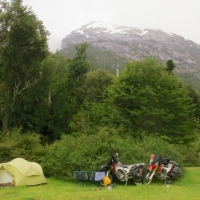 We feel like being alone in this world. Well, “together alone” anyway. The sun has disappeared behind the hills, so it cools down quickly. We pitch the tent, eat a full plate of pasta and drink some red wine
We feel like being alone in this world. Well, “together alone” anyway. The sun has disappeared behind the hills, so it cools down quickly. We pitch the tent, eat a full plate of pasta and drink some red wine  What a life!
What a life!
Distance to “Bush Camp Rio Exploradores” = 37.932km (23.570 miles)
Click here to view the photo gallery
Previous story “White peaks” – Next story “Carretera Austral (Part II)“





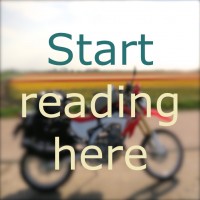


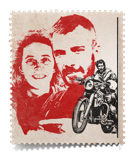
Zóóóo mooi!
Nu lekker deel II gaan lezen en kijken, leuk!
Groetjes
Mieke
Net alle foto’s nog een keer bekeken… Zo mooi! Morgen nog een keertje denk ik ;-).
Oh, wat heerlijk om deze prachtige foto’s van dit gebied te zien; K krijg helemaal heimwee naar Zuid Amerika!!
Tot snel :-).
xx Mip
Hoi Leonie en Peter.
Wat een mooi deel van jullie reis is dit.
Het blijft leuk om met jullie mee te doen
Op jullie reis.
Nog heel veel plezier.
Joke en Janleen
Wat een prachtige foto s. En Jan wil ook op die visplekjes!! Liefs.
Hey Vissertjes, jullie gaan lekkah! Ik moest ff heel hard gillen bij die prachtige lupineveldenfoto! wauwzer. En dan dat kalfje op de brug, wat lief.
Dikke knuffel,
Celine en Leon
Oooh nee,
“Aan het eind van de weg moeten we omdraaien.”
Aan de andere kant vertrekt de tour naar “The San Raffael glacier” boeken in Puerto Tranquilo.
Zijn jullie wel nar de “Caves de Marmol” geweest?
Maar inderdaad een waanzinnig mooi landschap.
En je kunt heel zuidelijk oversteken naar Argentinië.
Cochrane, Chili via de x83 naar Argentinië, erg mooie route.
Prachtig!
Liefs, Dienie
Wat een geweldig avontuur! Je beschrijft het ook zo goed.
Heel veel plezier verder. We leven met jullie mee.
Gr. Ben en anja